Toyota Corolla (E100)
| Seventh generation | |
|---|---|
_CSi_sedan_(2011-06-15)_01.jpg) | |
| Overview | |
| Manufacturer | Toyota |
| Production |
Jun 1991[1] – Aug 1998[2] July 1994 – July 1999 (Australia)[3][4] 1991-2002 (wagon) |
| Assembly |
Cambridge, Canada (TMMC) Fremont, United States (NUMMI) Toyota City, Japan Santa Rosa, Philippines Jakarta, Indonesia Adapazari, Turkey Altona, Australia Thames, New Zealand Samrong Tai, Thailand (Samrong plant) Karachi, Pakistan |
| Body and chassis | |
| Body style |
4-door sedan 3/5-door hatchback 2-door coupé 3/5-door liftback 5-door station wagon |
| Layout | FF layout |
| Related |
Sprinter Geo Prizm Holden Nova |
| Powertrain | |
| Engine |
Petrol: 1.3 L 2E I4 1.5 L 5A-FE I4 1.6 L 4A-FE I4 1.8 L 7A-FE I4 Diesel: 2.0 L 2C I4 2.2 L 3C-E I4 |
| Transmission |
4/5/6-speed manual 3/4-speed automatic |
| Dimensions | |
| Wheelbase | 97.0 in (2,464 mm) |
| Length | 172.0 in (4,369 mm) |
| Width | 66.3 in (1,684 mm) |
| Height |
Sedan: 53.5 in (1,359 mm) Wagon: 55.3 in (1,405 mm) |
| Curb weight | 1052 kg (2315 lb) |
| Chronology | |
| Predecessor | Corolla E90 |
| Successor | Corolla E110 |
The Corolla E100 was the seventh generation of cars sold by Toyota under the Corolla nameplate. This generation of Corolla was larger, heavier, and visually more aerodynamic than the model it replaced. With its 2465 mm (97 in) wheelbase, the Corolla had moved into the compact size class once occupied by the Corona and Camry. The Corolla again had an equivalent model Sprinter, with the Sprinter Trueno being equivalent to the Corolla Levin.
Design
Not only the wheelbase increased, but the new Corolla also received a wider track than did the 90-series.[5] The chunky, solid design reflected the desire of development chief Dr. Akihiko Saito to make a 'mini-Lexus', to build on the recent successes of Toyota's new flagship range. The sedan and hatchback have drag coefficients of Cd=0.33, the liftback is Cd=0.30, and the wagon/van are Cd=0.36.[6] The 100-series models used fewer body panels than their predecessors, for increased strength, lower cost, and fewer panel gaps (providing a cleaner appearance and lower wind resistance). The headlights were now from polycarbonate rather than glass.
Japan
_GT_Apex_coupe_02.jpg)
The standard Corolla model range included the three-door hatchback Corolla FX, four-door sedan and five-door station wagon (and light van) models. Also returning in this generation was the two-door coupé Corolla Levin. A 4WD variant of the sedan and station wagon was also available with a 1.6 liter petrol or 2.0 liter diesel engine.
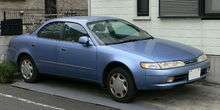
The four -door "pillared hardtop" Corolla Ceres and Sprinter Marino were introduced in 1992. They bore no real exterior resemblance but feature the chassis and most of the engine range of the standard Corollas, and used the Levin/Trueno dashboard. Minor face lift changes were introduced in May 1993. These included a new grille, a reconfiguration of the rear lamps and various other bits of trim and garnish.
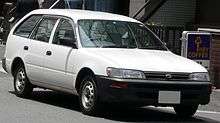
The E100 sedan and hatchbacks introduced in 1991 lasted until the introduction of the E110 in May 1995, while the E110 wagons and the related van continued in the Japanese market alongside the newer Corolla and Sprinter Carib models. Passenger wagons were available in 'G-Touring', 'L-Touring' and high-performance 'BZ-Touring' guises, while "Van" and "Business Wagon" models were basically stripped out wagons with leaf-sprung solid axle rear suspensions. Business Wagons typically had slightly higher equipment levels than simpler vans. The Corolla Touring Wagon continued until 2000, while both commercial versions continued to serve the Japanese market well into 2002, long outliving the mainstream E110 models in Japan. It was succeeded by the Probox.
| Engine | Power | Torque |
|---|---|---|
| 1.3 L 2E inline-four (petrol) | 72 hp (54 kW) | 72 lb·ft (98 N·m) |
| 1.3 L 4E-FE inline-four (petrol) | 99 hp (74 kW) | 81 lb·ft (110 N·m) |
| 1.5 L 5E-FE inline-four (petrol) | 104 hp (78 kW) | 100 lb·ft (140 N·m) |
| 1.5 L 5A-FE inline-four (petrol) | 104 hp (78 kW) | 100 lb·ft (140 N·m) |
| 1.6 L 4A-FE inline-four (petrol) | 113 hp (84 kW) | 100 lb·ft (140 N·m) |
| 1.6 L 4A-GE (20-Valve) inline-four (petrol) | 158 hp (118 kW) | 109 lb·ft (148 N·m) |
| 1.6 L 4A-GZE inline-four (petrol) | 168 hp (125 kW) | 120 lb·ft (160 N·m) |
| 2.0 L 2C inline-four (diesel) | 72 hp (54 kW) | |
| 2.2 L 3C-E inline-four (diesel) | 78 hp (58 kW) | |
Japanese market manual transaxles:
- C140 4M/T
- C50 5M/T
- C51 5M/T
- C52 5M/T
- C56 5M/T
- C160 6M/T
- S50 5M/T
- E59F 5M/T
- E55F 5M/T (4WD)
Japanese market automatic transaxles:
- A240L 4A/T
- A254E 4A/T
- A246E 4A/T
- A241L 4A/T
- A132L 3A/T
- A241H 4A/T (4WD)
Japanese market chassis:[7][8][9] The following list is not complete or inclusive.
- EE101 — 1.3L 4E-FE sedan, hatchback (DX, LX, XE).
- EE102 — 1.3L 4E-FE van.
- EE103 — 1.5L 5E-FE van
- EE104 — 1.5L 5E-FE business wagon.
- EE106 — 1.3L 2E van.
- EE107 — 1.5L 3E van.
- EE108 — 1.6L 3E business wagon.
- AE100 — 1.5L 5A-FE sedan (DX, LX, XE, SE-Limited), coupé (Levin S), and Wagon (L-Touring, G-Touring).
- AE101 — 1.6L sedan (SE-G, GT), FX hatchback (SJ, GT), Wagon (BZ-Touring), hardtop Ceres, and coupé (Levin SJ, GT, GT APEX, GT-Z).
- AE104 — 1.6L sedan 4WD (LX Limited, XE, SE Limited) and Touring Wagon 4WD.
- AE109 — 1.6L van 4WD.
- CE100 — 2.0L diesel sedan and Touring Wagon.
- CE101 — 2.2L diesel Touring Wagon.
- CE102 — 2.2L diesel business wagon.
- CE104 — 2.0L diesel sedan 4WD.
- CE105 — 2.2L diesel van 4WD.
- CE106 — 2.0L diesel van.
- CE107 — 2.2L diesel van.
- CE108 — 2.0L diesel business wagon.
- CE109 — 2.0L diesel van 4WD.
Asia
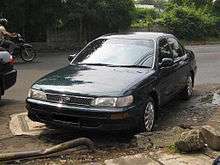

In the Philippines, the Corolla is nicknamed as the "Big Body". Three variants of the "Big Body" were sold, XL and XE with 1.3 liter carbureted (2E) engines, with the latter enjoying extra features like power steering, alloy wheels, digital clock and tachometer, and the GLi, with a 1.6 liter fuel-injected motor (4A-FE). The top model was offered in both manual and automatic transmissions. The Corolla "Big Body" was also the first 1.6 liter car to introduce 14-inch (360 mm) alloy wheels to the country in 1992. Other pioneer features that followed were rear seatbelts, front cup holders (late 1994) and a driver's airbag (late 1995). ABS followed during its later years.
The Corolla sedan is nicknamed the "Great Corolla" in Indonesia. Initially the trim levels were 1.3 SE and 1.6 SE-G. The smaller engine model was replaced by 1.6 SE in 1994.
The 1.3 XLi, 1.5 GLi sedan, wagon, and Levin 1.5 SJ coupé were sold in Hong Kong.
| Engine | Power | Torque |
|---|---|---|
| 1.3 L 2E inline-four (petrol) | 72 hp (54 kW) | 72 lb·ft (98 N·m) |
| 1.6 L 4A-FE inline-four (petrol) | 113 hp (84 kW) | 100 lb·ft (140 N·m) |
North America


In North America, the Corolla was new for the 1993 model year. It had different headlights (independent high/low beams), grille, bumpers (extended) and trunk garnish for the Base and DX Sedans. The base model came with the 1.6 liter 4A-FE engine. The DX, LE and wagon came with the 1.8 liter 7A-FE. The 1993 and 1994 versions of the 7A-FE engine were rated at 86 kW (115 hp), later versions rated at 78 kW (105 hp) mainly due to differences of the intake shape. Every model has fully independent suspension, front disk brakes and rear drum brakes.[10] The LE (Luxury Edition) has sporty front seats and was available in the US with A/T only or available in Canada with either A/T or M/T.
Minor changes occurred for the 1996 model year. Among these changes, the DX received bright red/clear tail lights and rear garnish, and new wheel covers. The Base model and CE Sedan came with restyled gray plastic trunk garnish. Sporty Corollas and 4WD Corollas were no longer imported during this generation. Some 1993 Corolla sedans sold were also produced in Japan, due to factory delays. All of the wagons were produced at the Takaoka plant in Japan.
In 1997, the DX wagon was dropped, but a special CE (Classic Edition) sedan was offered and it incorporated a number of popular features in one value-priced package. Among the standard goodies were power windows and locks, A/C, power steering, a four-speaker stereo, manual remote mirrors and special floor mats and exterior badging. All models received additional side-impact protection to meet new federal standards. And for the first time, during '97, all the Corollas sold in the United States were built in North America at the NUMMI plant in Fremont, California and the TMMC plant in Canada. By the end of the 1997 model year, the Corolla had become the best-selling nameplate in automotive history, overtaking the VW Beetle.
The coupé was dropped for North America, replaced by the Paseo.
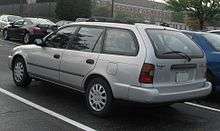
| Engine | Power | Torque |
|---|---|---|
| 1.6 L 4A-FE inline-four (petrol) | 100 hp (75 kW) | |
| 1.6 L 4A-FE inline-four (petrol) | 105 hp (78 kW) | |
| 1.8 L 7A-FE inline-four (petrol) | 105 hp (78 kW) | 117 lb·ft (159 N·m) |
| 1.8 L 7A-FE inline-four (petrol) | 115 hp (86 kW) | 115 lb·ft (156 N·m) |
North American market chassis codes:
- AE101 — Sedan 4-door with 1.6 4A-FE (Standard, CE)
- AE102 — Sedan 4-door and Wagon 5-door with 1.8 7A-FE (DX, LE)
South America
1993 model year Canadian-spec Corollas from Japan were sold in Chile because no Latin American models met emission standards by then. They featured a higher trim than most of its rivals at the time, since they all came with standard driver side airbag, larger bumpers, polycarbonate headlamp lenses. For the 1994 model year, a lower trim model was sold instead.
The Corolla sedan is nicknamed the "Baby Camry" in Venezuela.
In Perú and Bolivia, grey market imports from Japan are still highly popular.
In Brazil, official imports began in late 1992.
Europe
.jpg)
The five-door Sprinter was sold as the Corolla Sprinter in some markets in Europe, and simply the Corolla liftback in others. The three and five-door Corolla hatchback was also sold in Europe, where it took the lion's share of Corolla sales. It was available mostly in normal (non-sports) specs unlike the three-door-only FX range available in Japan, although some mildly hot models were also marketed.
In Europe, the hatchback sold better than the sedan and estate. Although basically the trim levels are Base, XLi and GLi, there was also the GS. The GS featured a fully color-coded exterior and with full electrics and a tilt/slide steel sunroof. It also had an upgraded interior with white dials and a rev counter. In UK the Corolla was marketed as S, CD, and CDX. A few select, rare models featured the 1.8L 7A-FE engine, including the 1.8 GXi 3-door hatchback in the UK, and the 1.8 XLi 4WD estate in certain markets. The sedan has its rear license plate mounted on the trunklid as opposed to the bumper on other region models.
In Europe's largest national auto-market, the E100 sustained the Corolla's reputation for reliability and economy. In 1995 it topped the small family car class in a reliability survey of 4-6 year old cars undertaken by the German Automobile Association (ADAC), with 5.3 recorded breakdowns per 1,000 cars for four-year-old cars and 10.1 for six-year-old cars: this compared with 12.0 breakdowns per 1,000 cars for four-year-old Volkswagen Golfs and 21.8 for six-year-old Golfs.[11] (The class loser was the Fiat Tipo with 38.3 breakdowns per 1,000 for four-year-old cars and 44.0 for six-year-old Tipos.[11])
| Engine | Power | Torque |
|---|---|---|
| 1.3 L 2E inline-four (petrol) | 72 hp (54 kW) | 72 lb·ft (98 N·m) |
| 1.3 L 4E-FE inline-four (petrol) | 99 hp (74 kW) | 81–86 lb·ft (110–117 N·m) |
| 1.6 L 4A-FE inline-four (petrol) | 113 hp (84 kW) | 100 lb·ft (140 N·m) |
| 1.8 L 7A-FE inline-four (petrol) | 118 hp (88 kW) | |
| 2.0 L 2C-III inline-four (diesel) | 72 hp (54 kW) | |

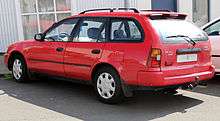
European market chassis:
- EE100 — 1.3L 2E
- EE101 — 1.3L 4E-FE
- AE101 — 1.6L 4A-FE
- AE102 — 1.8L 7A-FE
- AE103 — 1.8L 7A-FE 4WD
- CE100 — 2.0L 2C diesel.
Australia/New Zealand
_CSi_sedan_(2011-06-15)_02.jpg)
_RV_Seca_5-door_hatchback_(2012-10-26).jpg)
In late 1992, New Zealand-assembled E100 Corollas were introduced to the New Zealand market. These vehicles were assembled at Toyota's Thames factory. Trim levels consisted of 1.3L XL, 1.6L GL, 1.6L GS, and 1.6L GLX.[12] Available bodystyles were sedan, five-door hatchback, five-door liftback, and five-door wagon. The 1.3 is carburetted while the 1.6 is fuel injected, providing 81 kW (110 PS). The 1.6's lack of low-end power was mentioned by period road testers and later the torquier 1.8-liter engine was also made available. The entire Corolla range now received power steering as standard equipment. As with most other New Zealand-assembled Toyotas of the eighties and nineties, ex-racer Chris Amon had been allowed to adjust the suspension settings of the E100 Corolla.[5]
During 1994, the E100 Corolla became the first Toyota model to be built at the new Altona plant (production of the Corolla from 1968-1993 was at the Port Melbourne facility). This model came in hatchback (Seca) and sedan variants. The trim levels consisted of 1.6L CSi (base model), 1.6L and 1.8L CSX, 1.8L Conquest, sporty 1.8L RV (hatchback only) and the top of the range 1.8L Ultima (sedan only). Special edition models were included in the model lineup, and between 1994 and 1996 Toyota also imported the five-door liftback Sprinter model. In 1999, production of the E100 Corolla in Australia was terminated and Toyota Australia returned to Japanese imports, this time model AE112R.
References
- ↑ "Toyota Corolla (used and new) - specs and pics at AMAYAMA.COM". Specs.amayama.com. Retrieved 2010-10-03.
- ↑ "General Information • TOYOTA MOTOR MANUFACTURING TURKEY". Toyotatr.com. Retrieved 2010-10-03.
- ↑ "Overview of Overseas Production Affiliates: Oceania". Toyota Motor Corporation. 2012. Retrieved 2014-07-11.
- ↑ Dowling, Joshua (31 May 2002). "Lights out for Laser as Ford finds its focus". The Sydney Morning Herald. Retrieved 2014-07-11.
- 1 2 Anderson, Donn, ed. (March 1993). "The Generation Gap". New Zealand Car. Auckland, New Zealand: Accent Publishing Cnr. 7 (5): 35. ISSN 0113-0196.
- ↑ The Generation Gap, p. 37
- ↑ "トヨタ カローラ(COROLLA)のグレード一覧" [Toyota Corolla grade list] (in Japanese). Goo-net.com.
- ↑ "トヨタ カローラツーリングワゴン(COROLLA_TOURING_WAGON)のグレード一覧" [Toyota Corolla touring wagon grade list] (in Japanese). Goo-net.com.
- ↑ "トヨタ カローラワゴン(COROLLA_WAGON)のグレード一覧" [Toyota Corolla wagon grade list] (in Japanese). Goo-net.com. Retrieved 2010-10-03.
- ↑ "Toyota Corolla History". edmunds.com. Retrieved 2013-07-31.
- 1 2 "Pleiten, Pfusch und Pannen". ADAC Motorwelt: 38–48. May 1996.
- ↑ The Generation Gap, p. 34
| Wikimedia Commons has media related to Toyota Corolla (E100). |
| « previous — Toyota road car timeline, North American market, 1980s–present (model years) | ||||||||||||||||||||||||||||||||||||||
|---|---|---|---|---|---|---|---|---|---|---|---|---|---|---|---|---|---|---|---|---|---|---|---|---|---|---|---|---|---|---|---|---|---|---|---|---|---|---|
| Type | 1980s | 1990s | 2000s | 2010s | ||||||||||||||||||||||||||||||||||
| Model year | 0 | 1 | 2 | 3 | 4 | 5 | 6 | 7 | 8 | 9 | 0 | 1 | 2 | 3 | 4 | 5 | 6 | 7 | 8 | 9 | 0 | 1 | 2 | 3 | 4 | 5 | 6 | 7 | 8 | 9 | 0 | 1 | 2 | 3 | 4 | 5 | 6 | 7 |
| Subcompact | Tercel | Tercel | Tercel | Tercel | Tercel | Echo | Yaris Sedan | Yaris iA | ||||||||||||||||||||||||||||||
| Yaris Liftback | Yaris Liftback | |||||||||||||||||||||||||||||||||||||
| Starlet | Corolla FX | Prius c | ||||||||||||||||||||||||||||||||||||
| Corolla | Corolla | |||||||||||||||||||||||||||||||||||||
| Compact | Corolla | Corolla | Corolla | Corolla | Corolla | Corolla | ||||||||||||||||||||||||||||||||
| Matrix | Matrix | Corolla iM | ||||||||||||||||||||||||||||||||||||
| Corona | Camry | Camry | Prius | |||||||||||||||||||||||||||||||||||
| Mid-size | Prius | Prius | Prius | |||||||||||||||||||||||||||||||||||
| Cressida | Cressida | Cressida | Cressida | Camry Solara | Camry Solara | Prius v | ||||||||||||||||||||||||||||||||
| Camry | Camry | Camry | Camry | Camry | ||||||||||||||||||||||||||||||||||
| Mirai | ||||||||||||||||||||||||||||||||||||||
| Full-size | Avalon | Avalon | Avalon | Avalon | ||||||||||||||||||||||||||||||||||
| Sport compact | Corolla GT-S/SR5 | |||||||||||||||||||||||||||||||||||||
| Celica | Celica | Celica | Celica | Celica | Celica | |||||||||||||||||||||||||||||||||
| Paseo | Paseo | |||||||||||||||||||||||||||||||||||||
| Sports car | Celica Supra | Celica Supra | 86 | |||||||||||||||||||||||||||||||||||
| Supra | Supra | |||||||||||||||||||||||||||||||||||||
| MR2 | MR2 | MR2 Spyder | ||||||||||||||||||||||||||||||||||||